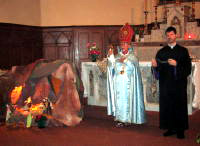C’EST NOEL POUR L’EGLISE ARMENIENNE
L’Église arménienne fête Noël le 6 Janvier et non le 25 Décembre, pour respecter le calendrier chrétien ancien, le calendrier Julien.

Programme du Nouvel An et de l’Epiphanie.
en l’eglise Saint Grégoire l’Illuminateur de Beaumont – Marseille
– Dimanche 6 janvier 2008
– Sourp Dzenount – Epiphanie
– 9.30h -début des cérémonies
– 10 h – Messe solennelle de Noel et Bénédiction de l’eau.
Eglise arménienne à Paris:
Cathédrale Sainte-Croix de Paris des Arméniens de France, 13 rue du Perche – 75003 Paris.
HISTOIRE
C’est sous l’impulsion de Saint Grégoire l’Illuminateur qu’en l’an 301 le christianisme devient religion d’Etat. En l’an 551, en désaccord avec certains dogmes, lors du concile de Dwin, l’Eglise Arménienne se sépare de l’Eglise de Rome. L’Eglise Apostolique Arménienne est née.
Les rites pratiqués se trouvent donc assez proches du catholicisme.
Bien sûr, c’est Garante Baba, à l’image du père Noël de la tradition catholique, qui fait la distribution. Il n’est pas rare de voir les agapes interrompues pour aller à la messe de minuit à l’église catholique la plus proche.
La diaspora arménienne étant installée en très grande majorité dans les pays occidentaux à forte composante catholique et protestante, la fête de Noël a lieu le soir du 24 décembre.
ARMENIAN CHRISTMAS
Armenia is located along the foothills of the southern part of the Caucasian range, between the Black and the Caspian seas. Two countries where Christianity predominates, namely Georgia to the west and Russia to the north, surround it, while two other countries where the Islamic religion prevails, Azerbaijan and Turkey, border its east and south frontiers, respectively.
Due to its geographic location, Armenia had to suffer various invasions and migrations, as it was making way to invaders and emigrants. However, one of the main consequences has been the conversion of the country to Christianity as early as the First century.
HISTORY
Through the impetus given by St Gregory the Enlightener, Christianity was officially endorsed by the Armenian state in 301, thus becoming state faith. In the year 551 a cleavage occurred between the Armenian Church and the Roman Catholic Church. The Armenian Apostolic Church was founded, based on quarrels about various dogmas during the Dwin Council.
In reaction to the various invasions, in 400 St Mesrop Machtotz designed the Armenian alphabet and began to translate the Holy Bible, thus introducing union in the Armenian population as well as consolidation and perpetuation of the nation.
The Armenian rites are therefore closely similar to those of the Roman Catholic Church.
According to the Armenian Apostolic Church beliefs, the Nativity takes place on 6 January, at Twelfth Night.
THE LEGEND
According also to the “legend”, the Three Wise Men saw the Evening Star shining in the sky at winter soltice. They therefore set off to arrive in time in Bethlehem for Jesus’ birth on 6 January and offer Him their presents that were gold, frankincense, and myrrh.
As the Armenian Diaspora mainly settled in occidental countries where Catholicism and Protestantism largerly prevail over the other religions, Christmas is celebrated in the evening of 24 December.
As Santa Claus, the Christmas figure in the Catholic tradition, Garante Baba distributes the gifts. To attend the midnight mass in the closest Catholic church, it is not unusual to interrupt the feast.




